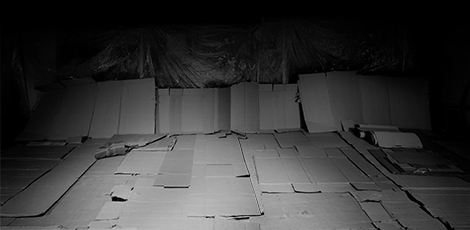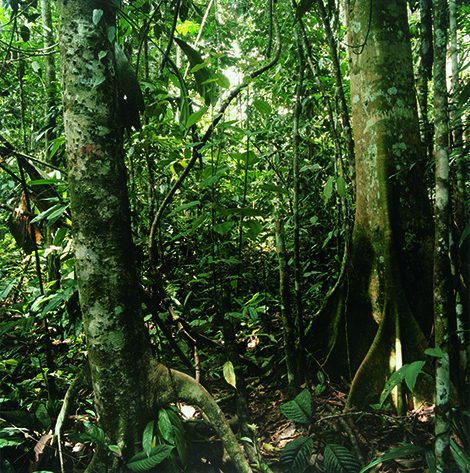Space and architecture constitute, for Gaston Bachelard in his book, The Poetics of Space, a site for our memories, which become real and find a location through the geography of constructed space. These locations, which function as markers on the road of our individual lives, allow us to make sense of the past. Where we have lived, where we have slept, worked or been incarcerated, feeds into the specificity of who we are.
The British artist, Hannah Collins, known for her large—sometimes more than six-meters wide—unframed photographs that create immersive spatial experiences, is fully aware of these resonances. The first gallery at Camden Arts Centre is hung with a number of these huge unframed prints, which envelop the viewer. Taken in the East End of London, when the East End was not the hip place it is today but a liminal neighborhood of poverty and cheap artists’ studios, the shabby mattresses and cardboard that proliferate in Thin Protective Coverings (1986) and The Violin Player (1988) suggest a struggle for temporary comfort and refuge. The unfolded sheets of cardboard are reminiscent of those used by rough sleepers for warmth, while the solitary, unidentified violin player, standing on one of many old mattresses, conjures the struggle and loneliness involved in much creativity. A black-and-white image of a discarded bookcase containing moldering books, a bottle and a fuel can, set inside a filthy room littered with birds’ feathers, depicts the hut in South Africa where Nelson Mandela spent his teenage years, alienated from his family.
Sound, both musical and spoken, runs like a motif through this exhibition. Family (1988), shows a collection of abandoned loudspeakers piled one on top of the other. In their relational positioning they are as anthropomorphic as Morandi’s bottles. While The Interior and the Exterior–Noah Purifory (2014), a photographic installation that fills an entire gallery, is a homage to the melancholy edifices, constructed from recycled detritus in the Californian desert, by the West-Coast artist. The three-channel soundscape brings together spoken accounts of Purifoy’s contemporaries, recorded by Collins, including Ed Ruscha and members of the Black Panthers. A time-lapse film Solitude and Company (2008), made inside a derelict factory in a rundown post-industrial town in Northern France also becomes a vehicle for sociological comment through the music of a local Algerian DJ and the voices of those recounting their lives and dreams.
“The Fertile Forest” (2013–15), an installation of photographs and texts gathered during time spent with the tribal peoples in the Amazon basin, explores the rich local flora and the variety of uses—from medicinal to hallucinogenic —to which these plants can be put. The final image of the show, a large black-and-white photograph of an ordinary road leading though a snowy landscape of pine trees, past an iron gate at the end of someone’s drive, might remain quite unremarkable until we learn that this is the road to Auschwitz. Hannah Collins’ pictures may, at first glance, seem deliberately unexceptional but they are steeped in social and cultural history that creates its own particular emotional cartography.



